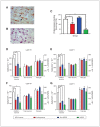Low levels of muscarinic M1 receptor-positive neurons in cortical layers III and V in Brodmann areas 9 and 17 from individuals with schizophrenia
- PMID: 30125244
- PMCID: PMC6158028
- DOI: 10.1503/jpn.170202
Low levels of muscarinic M1 receptor-positive neurons in cortical layers III and V in Brodmann areas 9 and 17 from individuals with schizophrenia
Abstract
Background: Results of neuroimaging and postmortem studies suggest that people with schizophrenia may have lower levels of muscarinic M1 receptors (CHRM1) in the cortex, but not in the hippocampus or thalamus. Here, we use a novel immunohistochemical approach to better understand the likely cause of these low receptor levels.
Methods: We determined the distribution and number of CHRM1-positive (CHRM1+) neurons in the cortex, medial dorsal nucleus of the thalamus and regions of the hippocampus from controls (n = 12, 12 and 5, respectively) and people with schizophrenia (n = 24, 24 and 13, respectively).
Results: Compared with controls, levels of CHRM1+ neurons in people with schizophrenia were lower on pyramidal cells in layer III of Brodmann areas 9 (-44%) and 17 (-45%), and in layer V in Brodmann areas 9 (-45%) and 17 (-62%). We found no significant differences in the number of CHRM1+ neurons in the medial dorsal nucleus of the thalamus or in the hippocampus.
Limitations: Although diagnostic cohort sizes were typical for this type of study, they were relatively small. As well, people with schizophrenia were treated with antipsychotic drugs before death.
Conclusion: The loss of CHRM1+ pyramidal cells in the cortex of people with schizophrenia may underpin derangements in the cholinergic regulation of GABAergic activity in cortical layer III and in cortical/subcortical communication via pyramidal cells in layer V.
Conflict of interest statement
Figures


References
-
- McGrath J, Saha S, Chant D, et al. Schizophrenia: a concise overview of incidence, prevalence, and mortality. Epidemiol Rev. 2008;30:67–76. - PubMed
-
- Jablensky A. Subtyping schizophrenia: implications for genetic research. Mol Psychiatry. 2006;11:815–36. - PubMed
-
- Sarter M, Bruno JP. Cortical acetylcholine, reality distortion, schizophrenia, and Lewy body dementia: Too much or too little cortical acetylcholine? Brain Cogn. 1998;38:297–316. - PubMed
-
- Gibbons A, Dean B. The cholinergic system: an emerging drug target for schizophrenia. Curr Pharm Des. 2016;22:2124–33. - PubMed
-
- Dean B, Scarr E. Possible involvement of muscarinic receptors in psychiatric disorders: a focus on schizophrenia and mood disorders. Curr Mol Med. 2015;15:253–64. - PubMed
Publication types
MeSH terms
Substances
LinkOut - more resources
Full Text Sources
Medical
Research Materials
